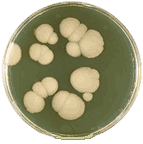Papers in the Biological Sciences
Date of this Version
2010
Document Type
Article
Citation
Ghosh, Suman, et al. "Candida albicans cell wall components and farnesol stimulate the expression of both inflammatory and regulatory cytokines in the murine RAW264. 7 macrophage cell line." FEMS Immunology & Medical Microbiology 60.1 (2010): 63-73.
Abstract
Candida albicans causes candidiasis, secretes farnesol, and switches from yeast to hyphae to escape from macrophages after phagocytosis. However, before escape, macrophages may respond to C. albicans’ pathogen-associated molecular patterns (PAMPs) through toll-like receptor 2 (TLR2) and dectin-1 receptors by expressing cytokines involved in adaptive immunity, inflammation, and immune regulation. Therefore, macrophages and the RAW264.7 macrophage line were challenged with C. albicans preparations of live wild-type cells, heat-killed cells, a live mutant defective in hyphae formation, a live mutant producing less farnesol, or an isolate producing farnesoic acid instead of farnesol. Interleukin-6 (IL-6), and IL-1b, IL- 10, and tumor necrosis factor-a (TNF-a) expression were evaluated by ELISA and/ or qRT-PCR within 6 h after challenge. All viable strains producing farnesol, regardless of hyphae phenotype, induced IL-6, IL-1b, IL-10, and TNF-a. To determine which components of C. albicans induced IL-6, RAW264.7 cells were incubated with farnesol, farnesoic acid, with or without zymosan, a yeast cell wall preparation that contains PAMPs recognized by TLR2 and dectin-1. The highest expression of IL-6, TLR2, and dectin-1 occurred when RAW264.7 cells were stimulated with zymosan and farnesol together. Our results suggest that the rapid expression of cytokines from macrophages challenged with C. albicans is due to cell-wall PAMPs combined with farnesol.
Included in
Environmental Microbiology and Microbial Ecology Commons, Other Life Sciences Commons, Pathogenic Microbiology Commons


Comments
Copyright 2010 Federation of European Microbiological Societies. Used by permission.